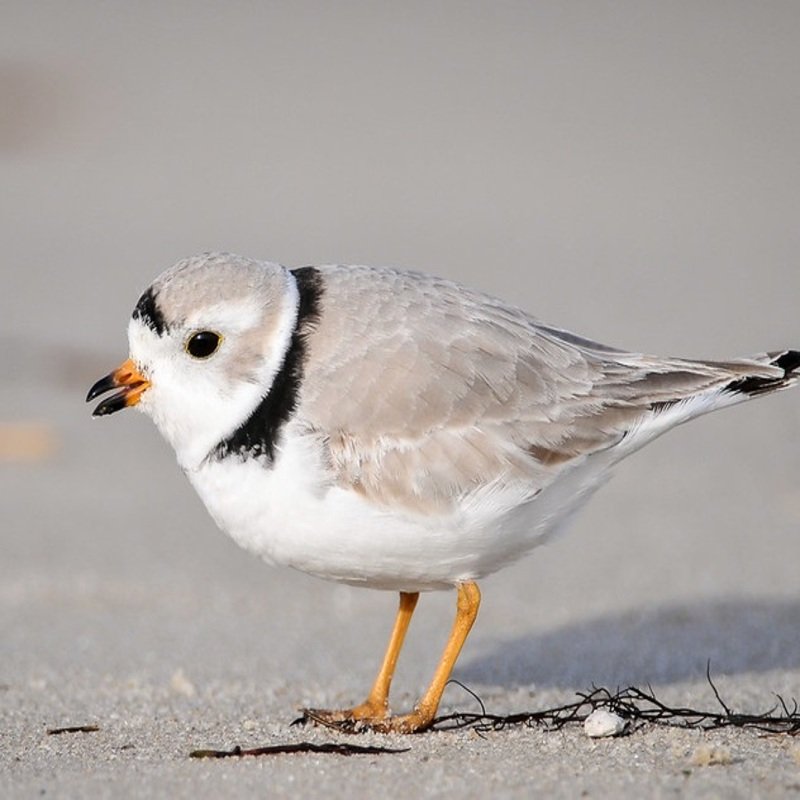The piping plover, Charadrius melodus is a little sand-colored shorebird about the size of a sparrow that nests and eats along North American coastal sand and gravel beaches. The name of the bird comes from its plaintive bell-like whistles, which are frequently heard before the bird appears. At the moment, the total population is believed to be between 7600 and 8400 inhabitants. Although intensive conservation groups have resulted in modest population increase, this trend is predicted to reverse if conservation efforts are discontinued.
Quick Overview: Charadrius Melodus – Piping Plover
Body size: Around 7.25 in (18 cm) and a weight of 54 g (1.9 oz)
Main colors: Brown, White, Yellow-Orange-Red, Black
Range: Eastern and United States
Migratory Bird: Yes
Best time of the year to see in the U.S.: January, February, December
Conservation Status: Near Threatened
Piping Plover Description
The piping plover is a little sand brown-colored shorebird about the size of a sparrow that nests and eats along North American coastal sand and gravel beaches. White upper tail with a black tip that is white-edged. Adults have yellow-orange-red legs, a black band going from eye to eye across their forehead, and a black stripe running along their breast line.

Size
These birds have a length of 7.25 in (18 cm) and a weight of 54 g (1.9 oz). Their wings could range from 19 in (48 cm).
Feeding
Piping plovers forage on exposed beach surfaces, pecking for crustaceans less than a half-inch below the surface. They are primarily active during the day and feed on insects, marine worms, crustaceans, and mollusks, as well as flies and beetle eggs, and larvae.
Habitat
Piping plovers prefer wide, flat, open, sandy beaches devoid of grass or other vegetation. In North America, piping plovers nest in three locations: along the coasts of the Great Lakes, along the banks of rivers and lakes in the Northern Great Plains, and along the Atlantic Coast.
Behavior
The rituals entail displays and behavior that vary slightly amongst birds. The most frequently observed display is a courtship flight in which the male plover circles through the air, continually peeping and frequently swooping quite close to the female.
Charadrius Melodus Scientific Classification
- Kingdom: Animalia
- Phylum: Chordata
- Subphylum: Chelicerata
- Class: Aves
- Order: Charadriiformes
- Family: Charadriidae
- Genus: Charadrius
- Species: Charadrius melodus
Subspecies
The piping plovers are classified into two subspecies: the eastern population is called Charadrius melodus melodus, while the mid-western population is called Charadrius melodus circumcinctus.
Best time of the year to see
The best time to see these birds in the United States is during the winter season (December to February).
Distribution of the Piping Plover in the USA
This species is almost typically found in open sandy places adjacent to bodies of water, such as the ocean or lakeside beaches or river sandbars. It is found along the Atlantic and Gulf Coasts during the winter, from Virginia to the Yucatan Peninsula; it migrates north to breed and south to winter.
The Piping Plover can be found in the following states in the United States – Alaska, North Dakota, South Dakota, Nebraska, Kansas, Oklahoma, Louisiana, Mississippi, Tennessee, Kentucky, Ohio, Maryland, Minnesota, Wisconsin, Michigan, Massachusetts, Rhode Island, Connecticut, New Jersey, and Delaware.

